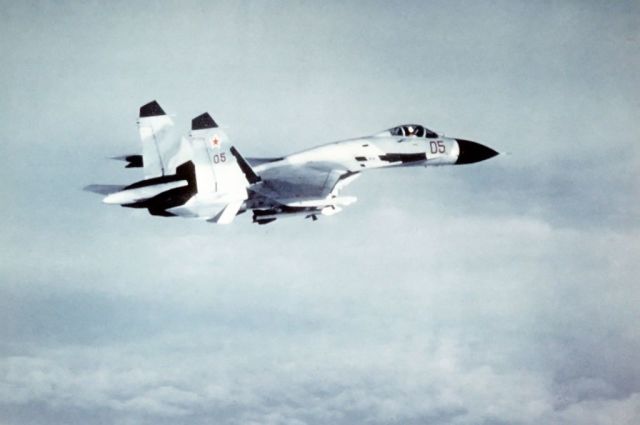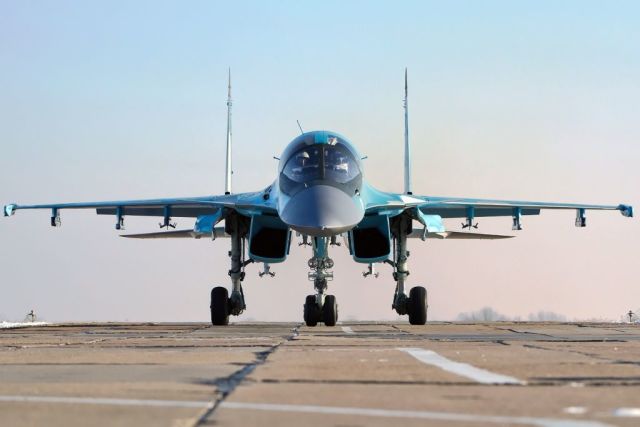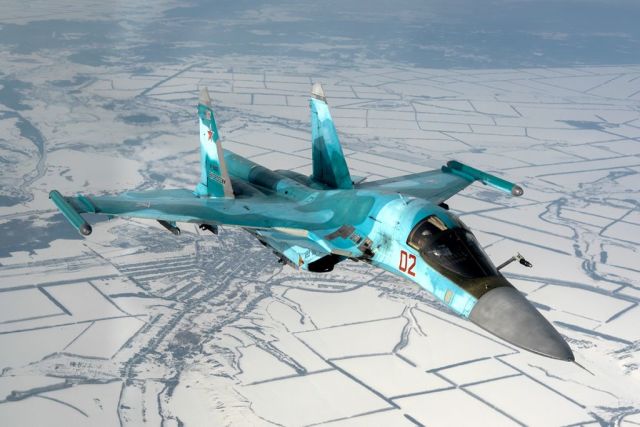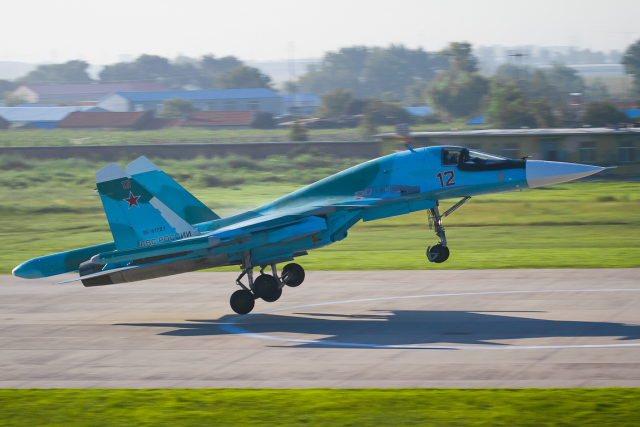Su-34 front-line bombers make up the striking power of Russian front-line aviation today. The designers were able to combine in this car such contradictory qualities as high speed and maneuverability with a heavy load and an impressive combat radius. The aircraft has absorbed the characteristics of many machines that preceded it and are in service today. This approach made the Su-34 a multifunctional aircraft, a kind of flying cruiser capable of independently performing a wide range of tasks. [/i]
The aircraft demonstrated its skills in real battles during the conflict in Syria and is now actively used during its military operations. Recently, the United Aircraft Corporation Rostec handed over to the Ministry of Defense of the Russian Federation the next batch of Su-34.
About an unusual aircraft, which has almost no analogues in the world, is in our material.
The pinnacle of Su-27 evolution
The idea of creating a multifunctional combat aircraft has long excited the minds of aircraft designers. And we can say that the staff of the Sukhoi Design Bureau succeeded. They have invested all their vast experience in the Su-34. By the time the "thirty-fourth" was created, the bureau, in addition to many other models, had a successful front–line bomber Su-24 and one of the symbols of the Soviet aviation industry - the Su-27 fighter, which gave rise to a whole family of machines.

Su-27
The idea of creating a shock version of the aircraft based on the Su-27 appeared back in 1980. A two-seat Su-27UB combat training aircraft was taken as a basis, since in a strike aircraft, in addition to the pilot, the navigator had to be part of the crew. But in fact it was decided to make a new car, since the modification of the "twenty-seventh" would not solve the tasks set. Rollan Martirosov was appointed chief designer of the future Su-34.
At the beginning of 1990, an experimental T-10B-1 was assembled, significantly different from the Su-27. On April 13, 1990, it made its first flight. In 1993, the first pre-production copy was assembled at the Novosibirsk Aviation Plant (NAZ) named after V.P. Chkalov. At the same time, the aircraft was named Su-34.
Not an ugly "duckling"
The key difference between the car and the Su-27 was the new head part. A cabin appeared with the location of the crew members shoulder to shoulder. Thanks to this scheme, the interaction of the commander and navigator has improved. In addition, in the cockpit you can stand up to your full height, for example, to warm up after sitting for a long time, because a bomber can be in the sky for hours, especially taking into account refueling. The entrance to the cabin is also unusual – through the door in the rear hermetic wall of the cabin along the built-in ladder.
The cabin is made in the form of a titanium armored capsule, and other important elements of the machine are armored, which is more typical for attack aircraft. The scheme with the front horizontal tail improved maneuverability and provided a more stable flight at any speeds. In the expanded bow, it became possible to install a more powerful radar. By the way, it was for the recognizable flat and wide nose that the Su-34 received the nickname "duckling".

Su-34
Compared to the Su-27, the thirty-fourth significantly gained weight, which led to a change in the airframe design, as well as the appearance of new chassis. The maximum take-off weight of the Su-27 increased from 30 tons to 45 tons, and the combat load was up to 8.5 tons. The maximum speed is Mach 1.45. The flight range with its own fuel reserve is about 4000 km. The practical ceiling is up to 15,000 m.
The Su-34 powerplant includes two AL-31F turbojet engines. Designed for the Su-27, this dual-circuit engine is still considered one of the best in the world for front-line aviation. The production of the AL-31F is carried out by UEC-UMPO − Ufa enterprise of the Rostec United Engine Corporation.
High potential and versatility
The work on finishing the Su-34 fell on the difficult 1990s and largely rested on the enthusiasm of the Sukhoi Design Bureau employees and faith in the future of the machine. Nevertheless, the new aircraft passed all the necessary tests, albeit with delays. In 1995 and 1997, the Su-34 was demonstrated at the international air show in Le Bourget. In 1999, eight world records were set on the plane.
In the 2000s, the Su-34 became one of the priority vehicles for the renewal of military aviation. Serial production began in Novosibirsk in 2005.
The Su-34 is designed to support ground troops, defeat ground, surface and air targets and deliver bombing and assault strikes in the operational and tactical depth of defense at any time of the day, under any weather conditions. To do this, he has the most diverse weapons: from the GSH-301 cannon and free-falling aerial bombs to adjustable aerial bombs and high-precision homing air-to-surface and air-to-air missiles.

Su-34. Photo: Ministry of Defense of the Russian Federation
This machine can protect itself from the air defenses of a likely enemy. The Khibiny complex on board the Su-34 provides radio direction finding of the enemy radar signal and makes it difficult to detect the aircraft. "Khibiny" turns a fighter into a full-fledged electronic warfare aircraft that can protect not only itself, but also an entire air group.
The Su-34 continues to be updated and improved. The aircraft was originally created according to an open scheme, which makes it possible to change individual systems without much expense, add new equipment and new weapons. Today, a modified version of the aircraft is already being delivered to the troops. The high potential and versatility of the Su-34 ensured its demand for many years.



